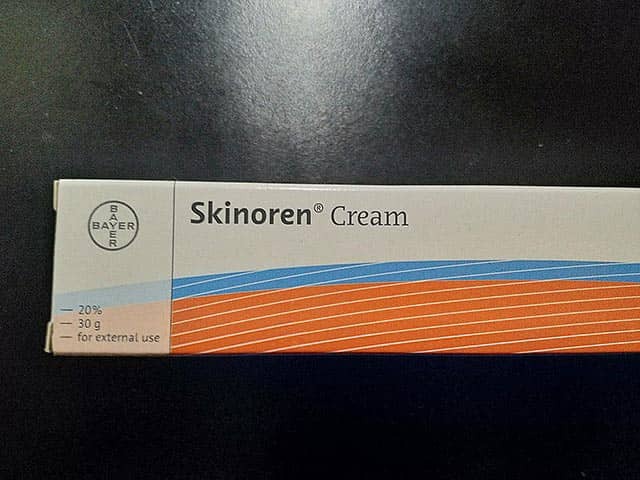Main menu
Common skin conditions

NEWS
Join DermNet PRO
Read more
Quick links
Azelaic acid — extra information
Azelaic acid
November 2022
Authors: Zena Al-Ani, The University of Auckland, New Zealand (2022)
Previous contributors: Dr Amanda Oakley Dermatologist, New Zealand (1999)
Reviewing dermatologist: Dr Ian Coulson
Edited by the DermNet content department
Introduction Uses Contraindications More information Benefits Disadvantages Side effects and risks
What is azelaic acid?
Azelaic acid is a dicarboxylic acid molecule with anti-inflammatory and antioxidant properties, effective in the treatment of acne vulgaris and papulopustular rosacea, among other cutaneous conditions.
Azelaic acid is a naturally occurring by-product of the metabolism of the yeast Malassezia furfur (also known as Pityrosporum ovale). In a number of countries, azelaic acid is available at a concentration of 20% as Skinoren™ cream, Acnederm™ lotion, and Azclear™ lotion. A 15% azelaic acid gel preparation was also approved for use in the US for rosacea, and a number of European countries for both rosacea and acne, eg, Finacea™ gel.

Pharmaceutical preparation of azelaic acid
What is azelaic acid used for?
Azelaic acid is predominantly used as a topical treatment for mild to moderate acne, and may be combined with oral antibiotics or hormonal therapy. It is useful for both comedonal and inflammatory acne vulgaris.
Azelaic acid, a tyrosine inhibitor, also helps reduce pigmentation, therefore is particularly useful for darker skinned patients whose acne spots leave persistent brown marks (postinflammatory pigmentation) or who have melasma.
Although not registered in New Zealand for other skin disorders, azelaic acid products may also be useful in the treatment of:
- Papulopustular rosacea
- Lentigo maligna, a type of early melanoma (note azelaic acid is not recommended for most cases of these precancerous lesions; where possible, surgery should be performed)
- Periocular dermatitis
- Periorificial dermatitis
- Rhinophyma.
What are the contraindications with azelaic acid?
- Azelaic acid hypersensitivity, or hypersensitivity to any of the topical cream components (such as propylene glycol).
Tell me more about azelaic acid
Azelaic acid has the following properties:
- Antibacterial — it reduces the growth of bacteria in the follicle (eg, Cutibacterium acnes, also known as Proprionibacterium acnes; and Staphylococcus epidermidis) by inhibiting protein synthesis
- Keratolytic and comedolytic — it improves the disordered growth of skin cells lining the follicle by inhibiting the proliferation and differentiation of human keratinocytes
- Anti-inflammatory — reduces inflammation by scavenging free radicals; specifically, inhibits mitochondrial oxidoreductases and reduces the generation of pro‐inflammatory oxygen derivatives in neutrophils.
Azelaic acid cream should be applied to the area affected by acne initially daily, then if tolerated building up to a generous twice-daily application after thoroughly cleansing the skin.
Acne responds slowly to treatment. Some improvement should be seen after one month of using azelaic acid cream. Further improvement should occur with maximum results after six months continuous use. Treatment may be continued safely for months or years if the acne remains active.
What are the benefits of azelaic acid?
Azelaic acid has both anti-inflammatory properties and targets hyperpigmentation. Its keratolytic properties means it is both exfoliative and comedolytic. It is a good option for acne treatment, with milder side-effects compared to more potent therapies. Some evidence suggests it is probably similarly effective to tretinoin for the treatment of acne.
Azelaic acid does not result in:
- Bacterial resistance to antibiotics
- Reduction in sebum production
- Photosensitivity (easy sunburn)
- Staining of skin or clothing
- Bleaching of normal skin or clothing.
What are the disadvantages of azelaic acid?
- Variable effect time, depending on the skin condition, severity, skin tone, and individual response to treatment.
- People typically see an improvement in their acne after about four weeks of treatment. People being treated for rosacea might need to use this medication for up to 12 weeks before their skin starts to get better.
- May cause skin lightening (hypopigmentation) that is more apparent in darker skin tones.
- Evidence suggests azelaic acid may be less effective for acne treatment than benzoyl peroxide when assessed using participants’ global self-assessment of acne improvement (PGA).
What are the side effects and risks of azelaic acid?
Azelaic acid is nontoxic and is well tolerated by most subjects. However, those with very sensitive skin or who suffer from eczema may find it irritating to apply, resulting in a mild irritant contact dermatitis.
Discontinue applying the cream and seek medical advice if you develop severe:
- Redness
- Scaling
- Itching
- Burning.
Worsening of asthma has also been reported with azelaic acid treatment; consult a physician if asthma exacerbation occurs with use.
Approved datasheets are the official source of information for medicines, including approved uses, doses, and safety information. Check the individual datasheet in your country for information about medicines.
We suggest you refer to your national drug approval agency such as the Australian Therapeutic Goods Administration (TGA), US Food and Drug Administration (FDA), UK Medicines and Healthcare products regulatory agency (MHRA) / emc, and NZ Medsafe, or a national or state-approved formulary eg, the New Zealand Formulary (NZF) and New Zealand Formulary for Children (NZFC) and the British National Formulary (BNF) and British National Formulary for Children (BNFC).
Bibliography
- Gupta AK, Gover MD. Azelaic acid (15% gel) in the treatment of acne rosacea. Int J Dermatol. 2007;46(5):533–8. doi:10.1111/j.1365-4632.2005.02769.x. Journal
- Liu H, Yu H, Xia J, et al. Topical azelaic acid, salicylic acid, nicotinamide, sulphur, zinc and fruit acid (alpha-hydroxy acid) for acne. Cochrane Database Syst Rev. 2020;5(5):CD011368. doi:10.1002/14651858.CD011368.pub2. Review
- Schulte BC, Wu W, Rosen T. Azelaic acid: Evidence-based update on mechanism of action and clinical application. J Drugs Dermatol. 2015;14(9):964–8. Journal
- Singh SK, Chaubey S, Bansal A, Kaur G, Malik DS. Cosmeceutical aptitudes of azelaic acid. Curr Drug Res Rev. 2021;13(3):222–9. doi:10.2174/2589977513666210526122909. Journal
On DermNet
- Acne
- Acne vulgaris
- Acne treatment
- Topical treatment for acne
- Rosacea
- Postinflammatory hyperpigmentation
- Melasma
- Lentigo
- Lentigo maligna and lentigo maligna melanoma
